|
View Larger Map |
A tour of the nation's capital: Delhi
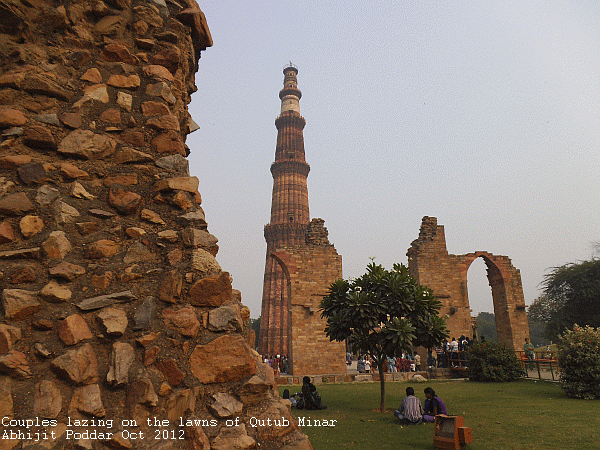
Delhi, more specifically New Delhi, is the capital city of our country. It had been my home when I was a child. After my marriage, I had taken my wife to visit the city and now, my son was eager to see the city for himself too. Interestingly, once having reached Delhi, one could plan a trip to one of many destinations in north India, like Agra, Jaipur, Simla, Haridwar, to name a few. It would be nice, so we thought, to embark on such an open-ended trip. The Puja vacation (we have a big holiday stretching for many days during the Durga Puja festival!) provided us the right opportunity to make such a trip and before long, we were on the Poorva Express, hurtling through the plains of North India towards Delhi.
We reached Delhi the following morning. The New-Delhi railway station where our train had arrived was, as expected, huge in size. It took us quite some time and effort to make our way to the exit on the Paharganj side. Most of the hotels, we were told, were to be found on this side of the station. No sooner were we out of the station, we were accosted by an autorikshaw-driver who kept pestering us to allow him to show us some of the good hotels around. Tired as we were after the long journey from Calcutta, we reluctantly agreed to his offer, although we stood the chance of being taken for a ride (figuratively speaking, since we had to take the autorikshaw ride nonetheless). It, however, proved to be a good decision, as we got to like the very first hotel he took us to. The hotel was sparkingly new, yet the room rates were very alluring.
After stretching our legs and having our bath, we went out to look for a place to have our lunch. We chose a pure vegetarian restaurant bang opposite the station and treated ourselves to a sumptuous north indian spread comprising of rotis, chawal, dal, sarso-ka-sag, alu gobi and papad, not to mention the salad, so typical in all meals in north india. Next we entered one of the many travel-agency shops lining the road opposite the station and booked three tickets for a one-day guided bus tour of the city.
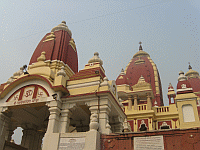
Next morning we embarked on the sightseeing tour, aptly named "Dilli-Darshan". A young lad, fluent in Hindi and not so fluent in English, was to be our tour guide for the day. As the bus started its journey through the dusty and congested roads of Paharganj, I took out my camera, inserted a fully charged set of batteries and made myself ready to take shots for uploading onto my web-site later. Our first destination was the Lakshmi Narayan temple (more commonly known as the Birla temple). Situated right in the middle of the city, it is big and impressive, yet not as grandoise as the famed temples one gets to see in many other parts of the country. Neither was it crowded with zealous devotees, most people inside being tourists like us. There was a small tea-shop in a 'galli' adjacent to the temple where we enjoyed sips of hot milky tea served in traditional earthen cups.
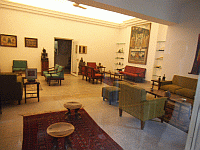
Our next destination would be the residence of the late ex-prime minister, Indira Gandhi's house which had been converted into a museum. As our bus meandered through the city towards the museum, one could not help but appreciate the wide, smooth and tree-lined roads. The museum housed the memoirs of the late ex-prime minister. It was a treasurehouse of old photographs of different generations of the Gandhi and Nehru families as well as different memorabilia like gift items presented to the late prime minister by heads of states and royalty. One could view the well furnished rooms used by the former prime-minister to study, dine and meet visiting dignitaries and reflect how her thoughts and viewpoints originating inside the walls of the house may have helped to shape the history of the country.
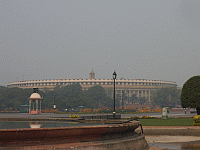
We moved on to see the seats of power, the Rashtrapathy Bhawan and the Parliament House. While the former is the grand residence of our president, the latter is where all legislative decisions are made. One would have liked to see the famed "Mughal Gardens" inside the Rashtrapathy Bhawan, but our tour itinerary did not permit it. India Gate, the memorial to the Indian soldiers who had perished in World War I, was our next stop. It is also a testimonial to the valour of all the soldiers who have sacrificed their lives for the cause of the nation. Next we moved on to see the most sought after tourist destination in Delhi, the Qutub Minar.
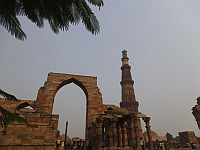
The Qutub Minar is a very tall tower or minaret having beautifully sculpted walls made of red sandstone. History has it that it was built by Qutubuddin Aibak, the slave of Muhammad Ghori, one of the first rulers of medieval India. It was purported to be the tallest building in the world in those times. When I was a child, I remember my father taking me up the spiralling staircase inside the tower, up to the first floor balcony from where one could have a stupendous view of the greenery around. Unfortunately, access to the staircase had long been stopped and one had to remain contented with the view of the tower and its surroundings from the ground-level only. The area surrounding the Qutub Minar had lush green lawns interspersed with majestic ruins of sandstone buildings of those times. There was also an iron-pillar, said to date back to the days of King Chandragupta Vikramaditya around 400 AD, still standing strong. A little further away there was an unfinished minar having a base area twice that of the Qutub Minar. It's construction was started by another Mughal ruler, Alauddin Khilji, who dreamt of building a tower twice as high as the Qutub Minar. Unfortunately, with his death the dream never got fulfilled.
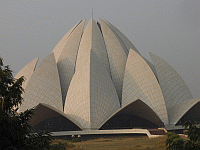
From the Qutub Minar we went on to see the Lotus Temple, but not before passing the Red Fort on the way. The Red Fort is also a must-see item on every tour-list, but for some strange reason, our tour operator had left it out of his itinerary. The Lotus Temple, nonetheless was a treat to the eyes. It was an architectural marvel. The building, we were told, is used for prayers by the people of the Bahai sect. It resembled a white lotus about to bloom. It also somewhat resembled the Sidney Opera House whose pictures are common in newspaper advertisements promoting tourism to Australia. We were told there was not much to see inside the temple and so moved on to our next and final destination, Rajghat, the 'samadhi' of Mahatma Gandhi.
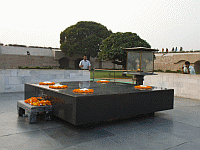
Mahatma Gandhiji was an epitome of peace and brotherhood. He was aptly cremated within the tranquil settings of what is now known to be Rajghat. A black, rectangular, elevated slab at the centre of the memorial is supposed to hold the ashes of the great Mahatma. People walk around the slab with folded hands and prayers on their lips, paying homage to the Mahatma. Vast areas surrounding the 'samadhi' were occupied by lush, green lawns where people from neighbouring colonies had come with their children to spend their evenings. As dusk started to engulf the area, the tranquility became all the more poignant and we set off on our return journey, back to the hotel.
The next morning we went on our own to explore the shopping area of Karol Bag. With clusters and clusters of shops selling every conceivable item on the planet, it looked pretty chaotic and crowded. There were traffic jams everywhere but I was surprised to note the patience and nonchalance of the drivers and people at large, refraining from shouting and taking everything in their stride. The area had many eateries and sweet-shops and after doing a bit of shopping we treated ourselves to delicious 'gulabjamuns' and 'kheer barfees'. In the evening we went on to see the 'Metro'. The Metro railway of Delhi had been put in place in record time just before the Commonwealth Games a few years earlier. As we hopped on and off a few trains, we were really impressed by the punctuality and its cleanliness. On one occasion, as we entered a compartment, we found a child had just vomited and made the floor dirty. A lady passenger pressed a switch and no sooner did the train stop at the next station, a 'sweeper' had arrived with his supervisor in tow. The duo spent the next few minutes helping clean the floor and only when they were done, the train left the station. That was some exhibition of efficiency. We hope our metro in Calcutta measures upto the same standards but again, with so many more people using our metro, one can't be sure whether that would be possible. We also crossed the Yamuna Bridge which skirts the city on the right and met a relative of ours. The wide, smooth roads with very helpful signage were a revelation indeed.
We had come to the end of our Delhi trip and had to decide where to go from here. The options were plenty, but our son was adamant we go and see the Taj Mahal. So it was decided we would go to Agra. The 'Delhi-Darshan' tour we had took did help us to see many places of interest in a short time. In the process, though, we had missed out seeing a few important places like the Red Fort, Humayun's Tomb, Jantar Mantar and the Akshardham Temple. That would have to wait for a future trip.
See you all in Agra....
P.S. All the photographs above have been taken by me or my son using our Canon and Fuji digital point and shoot cameras. I have optimised the images for the web using IrfanView.
Abhijit Poddar
Dept. of Electronic Sc.
Surendranath Evening College
24/2 Mahatma Gandhi Road
Kolkata 700009
email: abhipod at gmail dot com
© Abhijit Poddar All rights reserved.